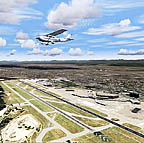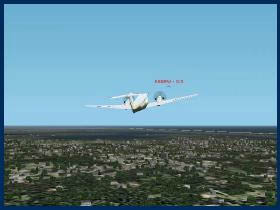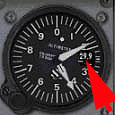Contents
|
||||||||||||||

Flight Simulator offers other ATC services, including traffic warnings, radar services, and current altimeter settings.
Important Notes
In multiplayer mode, you can connect over the Internet or a LAN to act as an air traffic tower controller for Flight Simulator pilots or interact as a pilot with a live Flight Simulator Tower Controller. To learn more, see Multiplayer Air Traffic Control in the Learning Center.
How about live instruction on any aspect of using Flight Simulator or on flying? You can give or receive instruction with another pilot or a friend over the Internet or a LAN using Flight Simulator's Shared Aircraft feature in multiplayer. To learn more, see Sharing the Aircraft in Multiplayer in the Learning Center.
Related
Links
|
||||||||||||
ATC Alert Messages
In Flight Simulator, ATC alerts you to situations in which certain things require your attention. Rather than scolding you, alert messages are designed to help you stay within expected parameters. Sometimes it's just a gentle reminder to help you stay on course, but also includes giving you vectors (directions) to avoid terrain. In most cases, you must either acknowledge the transmission or take the corrective action that the controller instructs you to take.
Traffic Messages from ATC
You're not alone out there. Just as in the real world, the Flight Simulator skies are full of other aircraft that may conflict with your flight path. Air traffic controllers may advise you of potential conflicts using "traffic calls" that include:
- Who the controller is addressing.
- Where the traffic is.
- What the traffic is.
- What you should do.
Example:
Controller: "Cessna 0MS; traffic is five miles; two o'clock; 7,500; type 767. Report them in sight."
The controller in this example is addressing Cessna 0MS. A Boeing 767 is five miles from Cessna 0MS at 7,500 feet. "Two o'clock" refers to the position of the traffic in relation to Cessna 0MS.

In other words, if Cessna 0MS was sitting on the face of a clock with its nose towards the 12, the little hand would point at the 2 on the clock-that is, the relative position at which the Boeing 767 is located. The controller wants to know if Cessna 0MS sees the traffic and wants 0MS to report if or when the traffic is in sight.
The pilot's response might be:
Pilot: "Traffic in sight, Cessna 0MS."
Or
Pilot: "Traffic not in sight, Cessna 0MS."
Warnings for traffic on parallel runways are different. You are warned of traffic on other runways if they are in the same phase of flight as you are. In other words, if you're landing, you'll get traffic warnings for aircraft landing on parallel runways. If you're departing, you'll get traffic warnings for aircraft departing on parallel runways. These warnings will only occur for parallel runways that are separated by 4,500 feet (1,372 meters) or less.
Other aircraft in the Flight Simulator world are marked with text labels. You will see the aircraft's call sign attached as a text label as the aircraft moves. These text labels can be turned off if you don't want to view them. To turn off labels, see Turning Off Aircraft Labels.
 Aircraft 888RW identified as 0.3 miles away. |
Aircraft Not Seen
If Cessna 0MS never sees the Boeing 767 (despite the size of this aircraft, it's more difficult than you might think to spot other planes in the sky), the controller may let the Cessna's pilot know when the traffic is no longer important. The pilot might hear:
Controller: "Cessna 0MS, traffic no longer a factor."
Type Unknown
Sometimes, the controller can only tell the pilot where the traffic is relative to the pilot's position. In that case, the pilot hears a position report, such as "...traffic is two o'clock..." If the aircraft referred to in the traffic report has a Mode C transponder (all aircraft in Flight Simulator are Mode C-equipped except the Schweizer, DC-3, and Piper Cub), the controller can give altitude information in the traffic call, such as, "...traffic is two o'clock, 5,000..."
If the controller doesn't know the type of aircraft, she will simply say, "...type unknown." If you have imported add-on aircraft into Flight Simulator, you may hear them referred to in traffic reports as "type unknown."
Traffic Alerts
When traffic is close and on a course and altitude that could present a hazard, the controller may begin the traffic call with the phrase, "Traffic Alert!" That's a cue to look quickly and carefully in the direction of the traffic. You may have to maneuver to avoid a collision.
When you are operating under VFR, ATC makes traffic calls only under certain circumstances. The controller may not advise you of all traffic that might conflict with your flight.
IFR Flights and Traffic Calls
If the pilot is on an IFR flight plan, ATC is watching the traffic around them. However, the controller is responsible for maintaining separation between aircraft within her airspace because, in theory, IFR aircraft are in clouds and the pilots can't see each other.
VFR Flights and Traffic Calls
If the pilot is operating under VFR rules, traffic calls are given when the pilot is transitioning airspace and talking to a controller, when the pilot is using Flight Following, and when the pilot is in the airport terminal airspace, provided the controller isn't too busy. Under VFR rules, it's the pilot's responsibility to maintain separation from other aircraft.
Speed Adjustments to Accommodate Traffic
Controllers may also ask you to adjust your speed to accommodate aircraft ahead or behind you that are slower or faster than your aircraft.
Airspace Transitions
The shortest route between two points is a straight line, and sometimes this means flying through controlled airspace. Because the airspace might be busy or have traffic that is bigger and faster than the pilot's aircraft (or vice versa), it makes good sense for the pilot to talk to a controller while in this airspace. The pilot could avoid this by flying around the airspace (which requires that the pilot have a sectional chart depicting the airspace), but that might mean adding considerable time and distance to the flight.
Getting a transition clearance is easy in Flight Simulator. Whenever you fly towards airspace in which a transition clearance is available or required, the ATC menu includes Request transition. When you select this item, you'll hear something like this:
Pilot: "Seattle Approach, Cessna N700MS, 10 miles east of Boeing Field, 5,000. Request clearance to transition Seattle Class B airspace."
Controller: "Cessna 0MS, Seattle
Approach, squawk 2212."
Pilot: "Squawk 2212, Cessna 0MS."
Controller: "Cessna 0MS, radar contact seven miles east of Boeing Field, 5,000. Cleared through the Seattle Class B airspace."
The pilot has addressed the ARTCC controller in Seattle stating who he is, where he is, at what altitude he's flying, and what he wants from the controller. The controller called 0MS and told him to dial 2212 into his transponder. 0MS responded by reading back the squawk code. Once the controller acquired 0MS's target on the radar screen, the controller told 0MS that she had radar contact, and then she cleared the Cessna through Seattle's Class B airspace. In the case of Class D airspace, the menu will display the name of the controller. That way you'll be able to choose which towered airspace you want to transition.
Once through the airspace, the ATC menu will contain the item Report clear of airspace. Select this item to let the controller know you're clear of the airspace.
Flight Following
Flight Following is a radar service for VFR aircraft that provides traffic advisories when the controller isn't too busy. It's a useful service when pilots are flying cross-country and may have to transition multiple controllers' airspaces, as they don't have to request a transition from each controller along the way and can get traffic advisories. It also means someone knows where they are, which can be reassuring if the engine quits over Death Valley or the Sahara. Keep in mind, however, that the pilot is still responsible for navigation while using Flight Following.
Any time you're in airspace where Flight Following is available and you're VFR in Flight Simulator, the ATC menu lists Request Flight Following as one of the options. When you select this item, you'll hear something like this:
Pilot: "Seattle Center, Cessna N700MS is type Skylane, five miles east of Bremerton National, for Flight Following."
Controller: "Cessna 0MS, Seattle Center, squawk 2212."
Pilot: "Squawk 2212, Cessna 0MS."
Controller: "Cessna 0MS, radar contact seven miles east of Bremerton, 5,000. Current altimeter 3102."
Pilot: "Roger, Cessna 0MS."
The pilot has addressed the ARTCC controller in Seattle stating who she is, where she is, at what altitude she's flying, and what she wants from the controller. The controller responded to 0MS, telling her to dial 2212 into her transponder. 0MS responded by reading back the squawk code. Once the controller acquired 0MS's target on the radar screen, the controller told the pilot that he had radar contact and then gave her the current local altimeter setting.
Altimeter Settings
The altimeter provides pilots with information about their aircraft's altitude. In other words, it tells them how high above mean sea level (MSL) they are. Altimeters work by measuring differences in atmospheric pressure at different altitudes. It's critical to know your altitude, especially when in the clouds, and the altimeter reading changes depending on local atmospheric pressure. For a more complete explanation of altimeters, see Flight Academy on the left side of the screen.
In some countries, altimeter settings are measured in inches of mercury, and in other countries in millibars. The controllers issue current local altimeter settings by stating the atmospheric pressure in inches of mercury or millibars. The pilot must then dial this setting into the Kollsman window of the altimeter (the small window on the altimeter face).
 The Kollsman window |
Controllers often provide local altimeter readings when the pilot first contacts the controller. Listen for phraseology similar to the following:
Controller: "...current altimeter 29.92."
When you hear this, check the current altimeter setting in your aircraft to make sure it matches the one the controller gave you. In Flight Simulator, you can choose whether the altimeter setting is in inches of mercury (U.S.) or millibars (metric).
|
To switch between U.S. and metric altimeter settings
|
|
To change the altimeter settings
|
Helicopter Operations
Flight Simulator ATC treats helicopter flights from the same as fixed-wing flights. You can request takeoff and landing clearance, and fly IFR approaches in the Bell 206B JetRanger III or the Robinson R22 Beta II. There are no special taxi or pattern-entry instructions issued to helicopter flights.
If you call the ground controller, you'll still be told to taxi to a runway to takeoff. You'll have to hover-taxi to the runway and land just short of it before the menu will list tower controller options. Alternatively, you can just take off from your parking spot without ever contacting ATC. After takeoff, the menu changes to a list of airports at which you can land.
ATC will not issue clearances to land on buildings, ships, or anywhere except an airport. You can, however, land a helicopter on many of the buildings in Flight Simulator.
Although ATC does not recognize that a helicopter is different from any other aircraft, when you land directly in a parking spot, the ATC menu will immediately display takeoff options (as opposed to options for taxiing options that you would see after landing on a runway).